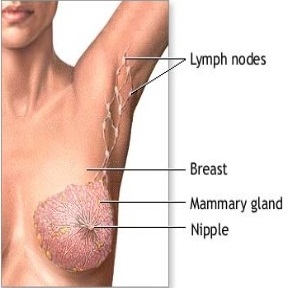
You may have heard others mention a stage of cancer. Have you wondered what that means? Here’s a quick overview: there are five stages, stage 0 refers to a cancer that is non-invasive and remains in its initial location, while stage 4 describes invasive cancers that have spread from the original location to other parts of the body. Then what about stage 1 breast cancer?
What Is Stage 1 Breast Cancer?
A stage 1 breast cancer diagnosis means the cancer cells have broken through the initialboundaries and are invading into tissue surrounding the cancer area. If you have stage 1 breast cancer, you will be told the category of either stage 1A or stage 1B.
In stage 1A breast cancer, your tumor measures up to 2 centimeters and has NOT spread beyond the breast. Your lymph nodes are still free from cancer.
In stage 1B breast cancer, you have no tumor, but the cancer is in smaller groups of cancer cells that are between 0.2 and 2 millimeters in the lymph nodes. You may or may not also have a tumor in the breast that is less than 2 centimeters.
Your stage 1 breast cancer may also have microscopic invasion. In microscopic invasion, the cancer cells are just starting to invade tissue outside the lining of the duct or lobule, but the group of invading cancer cells measure less than 1 millimeter.
Signs and Symptoms of Breast Cancer
You should be doing monthly breast self-exams. These exams will help you to be familiar enough to notice any changes. Consult with your healthcare provider if you find an abnormality.Butfinding something different doesn’t automatically mean you have cancer.
1. Breast or Nipple Feels Different
Feel your breast and surrounding areas, including the underarms for a lump or any areas of thickening of the skin. Also check for nipple tenderness or textural differences in the skin of your breast. This could include an enlarging of the pores or dimpling, which might make your skin appear similar to citrus peel. Remember if you find any of these symptoms, contact your healthcare professional and remember not all lumps are cancerous.
2. Breast or Nipple Changes in Appearance
Watch for any unexplained changes in size or shape, dimpling, swelling or shrinking (especially if it affects only one of your breasts). Also, if you notice an asymmetry between the two breasts that has not previously been the situation. As far as your nipples, watch for any turning inward or inverting, or if the nipple becomes red, swollen, scaly or forms ridges or pitting.
3. Nipple Discharges
And, if you have any milky discharge and are not breastfeeding, have that checked too, although it is unlikely to be connected to breast cancer, it should be checked by your healthcare professional.
Stage 1 Breast Cancer Treatments
With proper treatment, you have every chance to recove. Then you may wonder what the stage 1 breast cancer treatments are available. In a matter of fact, there are six possibilities.
1. Standard Treatment: Surgery
Undergoing surgical procedure for stage 1 breast cancer is a necessary. If the tumor is small, you can undergo lumpectomy. In this procedure, the tumor and the surrounding tissue are all removed. However, some women decide to get mastectomy or the process in which the whole breast is removed. The surgeon may likewise remove one or more of the lymph nodes. If you have a mastectomy, you could have reconstructive surgery later.
2. Adjuvant Treatments
- Hormone therapy. Hormone therapy is performed in women who have tumors that seem to be dependent on hormone estrogen. In these patients, medications are given to prevent the tumor from getting the hormone. Drugs like tamoxifen and aromatase inhibitors, including Femora, Aromasin and Arimidex, are given to premenopausal and postmenopausal women. Women who have not reached menopause can decide to get their ovaries be surgically removed to stop the growth of cancer.
- Radiation therapy. If you have a lumpectomy, you will probably have this to kill any cancer cells left behind with the surgery. Also, it's possible you might need this after a mastectomy.
- Chemotherapy. If you have a larger tumor, you will probably receive chemotherapy (cancer-killing drugs) after your surgery to increase your chances of success.
- Biological therapy. Biological therapy is a new approach to breast cancer. Studies show that 25% of women with breast cancer, the presence of protein known as HER2 is responsible for the spread of the cancer quickly. Herceptin is a drug that is approved in treating women that has metastatic breast cancer that is positive with HER2. This treatment stops the growth of cancer and makes the chemotherapy more effective. It is often used with combination in chemotherapy.
- Clinical trials. Many women with stage 1 breast cancer can choose to undergo clinical trials. A clinical trial can give you access to cutting-edge treatments. Clinical trials include new treatments, new drugs and new combinations. Always remember that successful treatments that are now used to treat breast cancer had started in a clinical trial.
Want to know more about treatment options for early stage breast cancer? Check out this video: